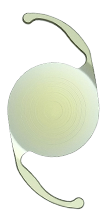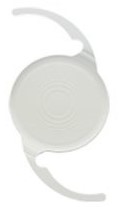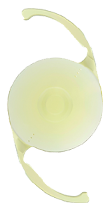Advanced Options for a
Premium Experience:
Request a Cataract Consultation
What is a Cataract?
A cataract is a clouding or opacity within the eye’s lens (see video below). The lens, like that of a camera, is important for focusing light rays onto the retina. When the lens becomes cloudy, light rays do not pass into the eye easily, resulting in blurry vision.There are many types of cataracts. The more common types are listed below:
- Age Related Cataract: Age Related Cataract is the most commonly treated type of cataract by ophthalmologists. This type of cataract is part of the normal aging of the natural lens of the eye. Over time the flexible proteins in the lens start breaking down and form clumps resulting in cloudy vision due to the cataract.
- Traumatic Cataract: This type of Cataract is usually due to an injury to the eye.
- Secondary Cataract: When cataract surgery is performed the sac in which the natural lens was situated is now used to put the new lens into. However, over time there is protein deposition in this sac, which once again results in clouding of the vision due to the secondary cataract. This is easily treated with a YAG laser.
- Pediatric Cataract: Cataracts can happen in babies and children and may be from birth (congenital), trauma related or due to other underlying disease. Pediatric cataracts must treated promptly to avoid amblyopia (lazy eye).
A cataract is a clouding of the eye’s internal lens. When the lens becomes cloudy, blurry vision results.
A cataract may not need to be treated if the vision is only slightly blurry. There are no medications, eyedrops, exercises, or glasses that will cause a cataract to disappear once formed. Surgery is the only way to remove a cataract. When you are no longer able to see well enough to do the things you like to do, cataract surgery should be considered.
In cataract surgery, the cloudy lens is removed from the eye through a small surgical incision, and the lens is replaced with a permanent intraocular lens (IOL) implant. This surgery is performed on an outpatient basis. Dr. Mudgil typically uses topical drops to numb the eye, and the anesthesia staff administers IV sedation to help keep the patient relaxed. There is no pain with cataract surgery.
The short answer is YES, at least some of the time. Most patients who receive a traditional monofocal IOL see well enough to drive without glasses after surgery. There is no guarantee that glasses will not be necessary after cataract surgery, as that is not the primary purpose of standard surgery. However, if you are a candidate for a premium intraocular lens (IOL), the spectacle dependency can be reduced for either distance, reading, or both. Please see the link for Premium IOL. At the time of your cataract consultation, we will discuss your Premium lens options with you.
Once a cataract has been removed it will never come back. However, there is a chance that the posterior capsule membrane that rests behind the IOL can get cloudy in time. Some call this a “secondary cataract,” but the correct term for this condition is “posterior capsule opacification” (PCO). PCO is treated with a painless laser procedure called YAG laser capsulotomy. The procedure takes about two minutes and does not require an incision or a return to the operating room. Once PCO has been treated, it should never occur again.
No Stitch, No Needle Cataract Surgery
At Mudgil Eye Associates, our standard cataract surgery is phacoemulsification assisted, small incision surgery. The incision is typically 2.4mm and usually does not require any sutures! Additionally, the anesthesia is typically topical drops and intraocular lidocaine, so no needle is given into the eye socket for anesthesia! This allows for a much more comfortable, quick procedure, and any patient anxiety is alleviated by gentle IV sedation. After the surgery, the patient is sent to the recovery room, where he/she is given a light snack to break the overnight fast; after the post-operative instructions are reviewed, the individual is usually discharged within 30-40 minutes from surgery. This minimally invasive technique enables faster recovery and resumption of normal activities; many individuals are able to return to work later the next day!
Laser (femtosecond) Cataract Surgery
Some benefits of Laser Cataract Surgery include:
- 3D mapping of the anterior segment of the eye for surgical planning
- Reduction of astigmatism using limbal relaxing incisions, particularly when the astigmatism is below threshold for premium Toric IOL
- Laser-precise accuracy for incision-making
Advanced Technology Lenses
Premium/Advanced Technology intraocular lenses (IOLs) are a family of intraocular lenses that are designed to give enhanced vision performance relative to a standard monofocal IOL. These upgrade lenses are not covered by insurances, as they are considered elective options to reduce spectacle dependency. At Mudgil Eye Associates, we offer a variety of premium intraocular lenses. While there is no perfect intraocular lens, and no lens can completely restore vision to your youthful years or guarantee a particular outcome, the premium intraocular lenses are an attractive option for those with active lifestyles who desire to maximize their freedom from spectacles.
PanOptix is the only trifocal IOL available in the US for implantation during cataract surgery. It has been one of the leading presbyopia-correcting IOLs in more than 70 countries, and it was FDA approved for US patients in August 2019. In US clinical studies, more than 99% of PanOptix recipients indicated that they would choose the same IOL again. PanOptix reduces the need for glasses post-operatively by its proprietary trifocal design, which allows patients to read at near and intermediate ranges, such as mobile devices and computer screens, while also providing high quality distance vision. The IOL is available in both spherical and toric powers, making it an option for patients with regular corneal astigmatism.
The Symfony IOL has recently been approved by the FDA as a multifocal implant, allowing for improved distance and reading vision. It is specifically designed to provide a broader range of continuous vision, and it usually allows patients to read closer than what can be achieved with the Crystalens (accommodating IOL) family. With typical multifocal IOLs, patients can experience an increase in night vision glare and halo symptoms, which are most common during the first year after surgery.
However, the Symfony multifocal lens design is unique in that it is marketed as reducing glare and halo symptoms to only what is expected from an ordinary monofocal IOL. The Symphony IOL also has reduced chromatic and spherical aberration distortion, allowing for better contrast enhancement. An exciting feature of the Symphony IOL is that is also available as a toric implant, allowing patients with corneal astigmatism to also benefit from this technology. This new IOL option is for patients who want excellent postoperative vision at most distances, to minimize spectacle dependency. The Symfony implant has been offered in Europe since 2014, where it has produced outstanding results for tens of thousands of patients. If you are interested in reduced spectacle dependency after cataract surgery, we will discuss which of the available options are ideal for your unique condition.
iStent® for Glaucoma with Cataract
For patients with mild to moderate glaucoma, the iStent® device is an exciting FDA approved implant option for lowering intraocular pressure. The iStent is literally the world’s smallest medical implant device. It is implanted into the trabecular meshwork at the same time as the cataract surgery, without need for additional incisions or anesthesia. Clinical trials demonstrated that patients who had cataract surgery combined with iStent® placement had lower eye pressures and required fewer glaucoma drops, than glaucoma patients who had cataract surgery alone. The iStent® may help reduce a patient’s medication burden, reducing the cost, inconvenience, or side effects of topical glaucoma therapy. The iStent® may also help delay or avoid the need for more risky surgical interventions in the future. The iStent® is covered by most insurances, and it is considered a minimally invasive form of glaucoma surgery. If you are on drops for glaucoma and are to undergo cataract surgery, this may be a suitable procedure for you to achieve better glaucoma control and/or reduce your dependency on eye drops.
The main risks of the iStent® procedure are predominantly the same as those associated with cataract surgery alone. Additional risks unique to the iStent® include:
- Failure to significantly improve eye pressure, in which case you would continue with the same glaucoma medications. In general, it takes at least 6 weeks to determine intraocular pressure outcome.
- Dislocation of the iStent®, which may require a second surgical procedure to reposition or remove the device.
- Obstruction of the lumen of the iStent® by your iris or other tissue within the eye.
- Bleeding at the site of the iStent® insertion. This is common and usually self-limiting. Rarely, this may be significant and result in delay of visual recovery or eye pressure rise.




